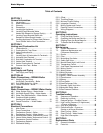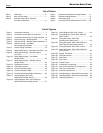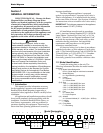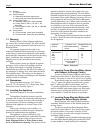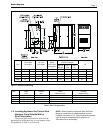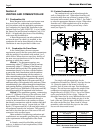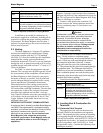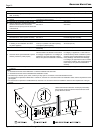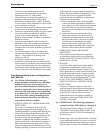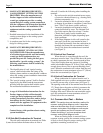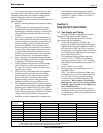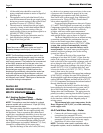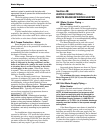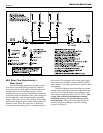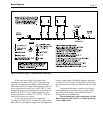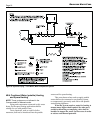
Brute Magnum
Page 11
1. The figure in this addendum shows the
requirements for mechanical vent terminal
clearances for the U.S. and Canada.
2. Vent terminals for condensing appliances or
appliances with condensing vents are not
permitted to terminate above a public walkway,
or over an area where condensate or vapor could
create a nuisance or hazard.
3. Locate the vent terminal so that vent gases cannot
be drawn into air conditioning system inlets.
4. Locate the vent terminal so that vent gases cannot
enter the building through doors, windows,
gravity inlets or other openings. Whenever
possible, locations under windows or near doors
should be avoided.
5. Locate the vent terminal so that it cannot be
blocked by snow. The installer may determine
that a vent terminal must be higher than the
minimum shown in codes, depending upon local
conditions.
6. Locate the terminal so the vent exhaust does
not settle on building surfaces or other nearby
objects. Vent products may damage such
surfaces or objects.
7. If the boiler or water heater uses ducted
combustion air from an intake terminal located
on the same wall, locate the vent terminal at least
3 feet (0.9m) horizontally from the combustion
air terminal, and locate the vent terminal at least
1 foot (0.3m) above the combustion air terminal.
From Massachusetts Rules and Regulations
248 CMR 5.08:
(a) For all side wall horizontally vented gas
fueled equipment installed in every dwelling,
building or structure used in whole or in
part for residential purposes, including those
owned or operated by the Commonwealth and
where the side wall exhaust vent termination
is less than seven (7) feet above finished grade
in the area of the venting, including but not
limited to decks and porches, the following
requirements shall be satisfied:
1. INSTALLATION OF CARBON MONOXIDE
DETECTORS
At the time of installation of the side wall
horizontal vented gas fueled equipment, the
installing plumber or gasfitter shall observe that
a hard-wired carbon monoxide detector with
an alarm and battery back-up is installed on the
floor level where the gas equipment is to be
installed. In addition, the installing plumber or
gasfitter shall observe that a battery operated or
hard-wired carbon monoxide detector with an
alarm is installed on each additional level of the
dwelling, building or structure served by the side
wall horizontal vented gas fueled equipment. It
shall be the responsibility of the property owner
to secure the services of qualified licensed
professionals for the installation of hard-wired
carbon monoxide detectors.
a. In the event that the side wall horizontally
vented gas fueled equipment is installed in a
crawl space or an attic, the hard-wired carbon
monoxide detector with alarm and battery
back-up may be installed on the next adjacent
floor level.
b. In the event that the requirements of this
subdivision cannot be met at the time of
completion of installation, the owner shall
have a period of thirty (30) days to comply
with the above requirements; provided,
however, that during said thirty (30) day
period, a battery operated carbon monoxide
detector with an alarm shall be installed.
2. APPROVED CARBON MONOXIDE
DETECTORS
Each carbon monoxide detector as required
in accordance with the above provisions shall
comply with NFPA 720 and be ANSI/UL 2034
listed and IAS certified.
3. SIGNAGE
A metal or plastic identification plate shall be
permanently mounted to the exterior of the
building at a minimum height of eight (8) feet
above grade directly in line with the exhaust vent
terminal for the horizontally vented gas fueled
heating appliance or equipment. The sign shall
read, in print size no less than one-half (½) inch
in size, “GAS VENT DIRECTLY BELOW.
KEEP CLEAR OF ALL OBSTRUCTIONS."
4. INSPECTION.
The state or local gas inspector of the side
wall horizontally vented gas fueled equipment
shall not approve the installation unless, upon
inspection, the inspector observes carbon
monoxide detectors and signage installed in
accordance with the provisions of 248 CMR
5.08(2)(a) 1 through 4.
(b) EXEMPTIONS: The following equipment is
exempt from 248 CMR 5.08(2)(a) 1 through 4:
1. The equipment listed in Chapter 10 entitled
“Equipment Not Required To Be Vented” in the
most current edition of NFPA 54 as adopted by
the Board; and
2. Product Approved side wall horizontal vented gas
fueled equipment installed in a room or structure
separate from the dwelling, building or structure
used in whole or in part for residential purposes.



